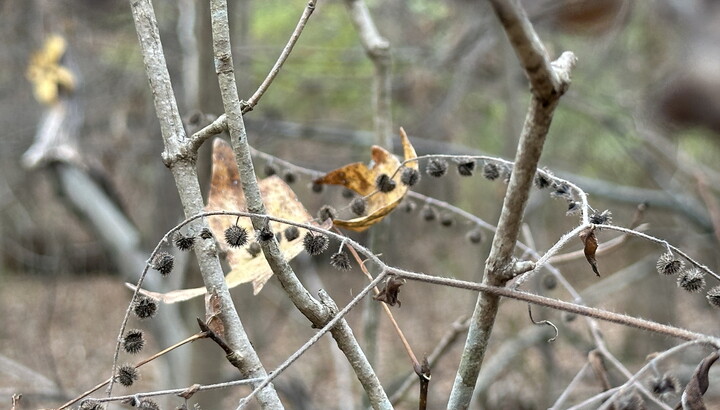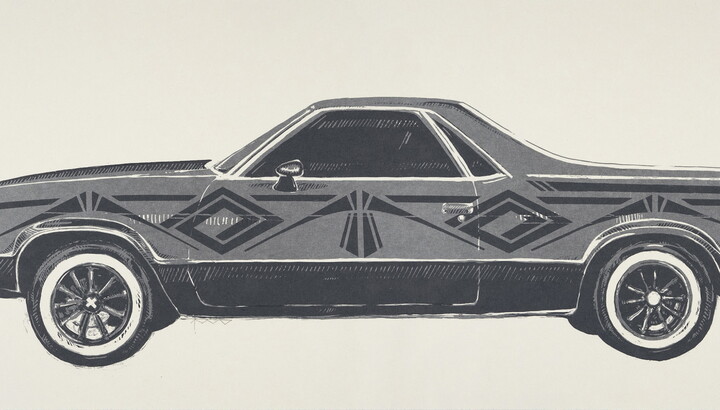The Carter Blog
Carter ARTicles
View from Here: Carter Community Artists
Apr 05, 2023
In her series View from Here, Christina Fernandez explores how people see the world by taking photos through the windows of the homes and studios of historical figures and artists. Each image presents a different perspective, whether an artist's view out her window at a Japanese internment camp or two sisters' views from the lighthouse where they were the final custodians. Fernandez's focus on the interior leaves the exterior slightly blurred, transporting the viewer to each person's intimate space. The tightly cropped, vertical images become, as she calls them, "portraits of that person through their vision."
In response to this series, we asked our 2023 Carter Community Artists about the views from their home or studio and how their views have shaped or inspired their artistic practices.
Rebecca Shewmaker
Through the window in my studio, I see my front lawn, the street, and my neighbors’ houses and cars. My indoor-only cat enjoys looking out of the studio window much more than I do. He avidly stares at birds, dog walkers, and cars passing by. I imagine him scheming of ways to escape to the outdoors and having dangerous adventures in the neighborhood. My lack of interest in the view through my studio window forces my focus back inside to my work. However, inspiration for me does involve looking outdoors. I take car trips to various places I want to depict in my work. During the trips, I look out my car’s windows, through the viewfinder of my camera, or simply through my eyeglasses. Then, back in the studio, I spend months creating landscape images. I plan compositions, dye fabric, and sew threads for seemingly endless hours with my sewing machine and by hand. I most appreciate my window when the light through it helps me distinguish among my 1,000+ spools of thread to pick the best shade of a particular color for my work. While the view through the studio window is rarely interesting enough to distract me, it does serve as a reminder that inspiration is never that far away. Like my cat, I am scheming of new adventures while working inside.
Adam Fung
The view from my studio includes the domestic sphere, as I work adjacent to the family home. This blurring of boundaries shapes my studio practice and art in many ways. I can turn from my easel and see my kids in the backyard, the daylight changing, or a neighbor hanging clothes to dry. My studio view sometimes is interrupted by a visitor like my son who critiques my work, my daughter setting up to make her own drawing, or my partner stopping in to see the latest progress as she gets home from work. This checking in on my studio practice is sometimes an inconvenience or interruption, but at the same time it keeps my practice grounded in the “real world.” This connection is important as I work to create paintings that reflect our collective responses to climate change and to how I initiate that conversation across the landscape-based paintings of my recent series. The proximity of my workspace to home is also valuable, as I often move in and out the studio during my day, whether it’s drinking my morning coffee staring at work in progress or squeezing in a late-night painting session.
Kathy Brown
As a first-time homeowner, in gratitude, I’ve peered out of my upstairs art studio window many times but hadn’t fully considered the visuality of the window’s vertical plane because the view changes with my positioning. For example, from the desk’s chair I primarily see rooftops (my neighbors and that of my attached garage), while standing close to the glass and looking straight ahead, I see the neighborhood beyond. But if I sit on the floor and look up, the sky and treetops frame my view. What’s consistent from all three angles are rooftops, which for me denote zenith points, endless possibilities, and a pondering of what’s next. How I interact with the window dictates my perspective, reminding me that my paradigms have evolved with my positioning. Experience and time have influenced my artistic big ideas, subject matter, methodologies, and creative research. However, no matter how I choose to look through the glass, daylight always permeates, illuminating everything in the room and offering a fresh perspective. My work honors the ancestors, acknowledges the complexities of the present while speculating Black futures, and so the window’s light inspires me to continue creating and know that with morning light, opportunity awaits beyond the horizon.
Olivia Garcia-Hassell
The view from my “studio” reflects much of what I attempt to capture when I write, draw, or paint. I put “studio” in quotation marks because while there is a photo of me sitting in my garage “studio,” where I have a collection of art supplies, lately my work has felt intangible. Like birdsong, chicken squalls, rooster calls, and chain link twinkling in the wind, I’ve been all over the place. Ebbing and flowing, making art, teaching art, not making art, not writing, and transitioning. My studio is in my garage. A space that is connected to my home by our driveway and a patio in the backyard. When I open the garage door, I have a wall-sized view of my neighbors, the street, the cars, and a little three-legged dog who visits my dog. I see green grass with white sparkling reflections of sunlight, the darkness of shadow under the dog as he walks past. I imagine how I would put that on paper with the edge or tip of the pencil, where I would blend or erase, where the highlights would go, what colors I would use to paint the shadows and the sparkles, and how I would curve lines and use color to add expressions.







